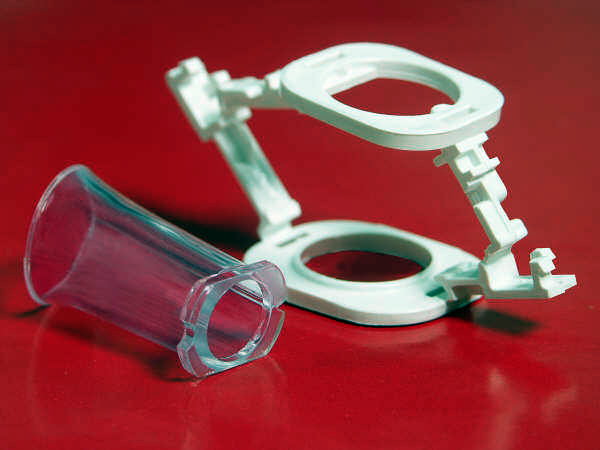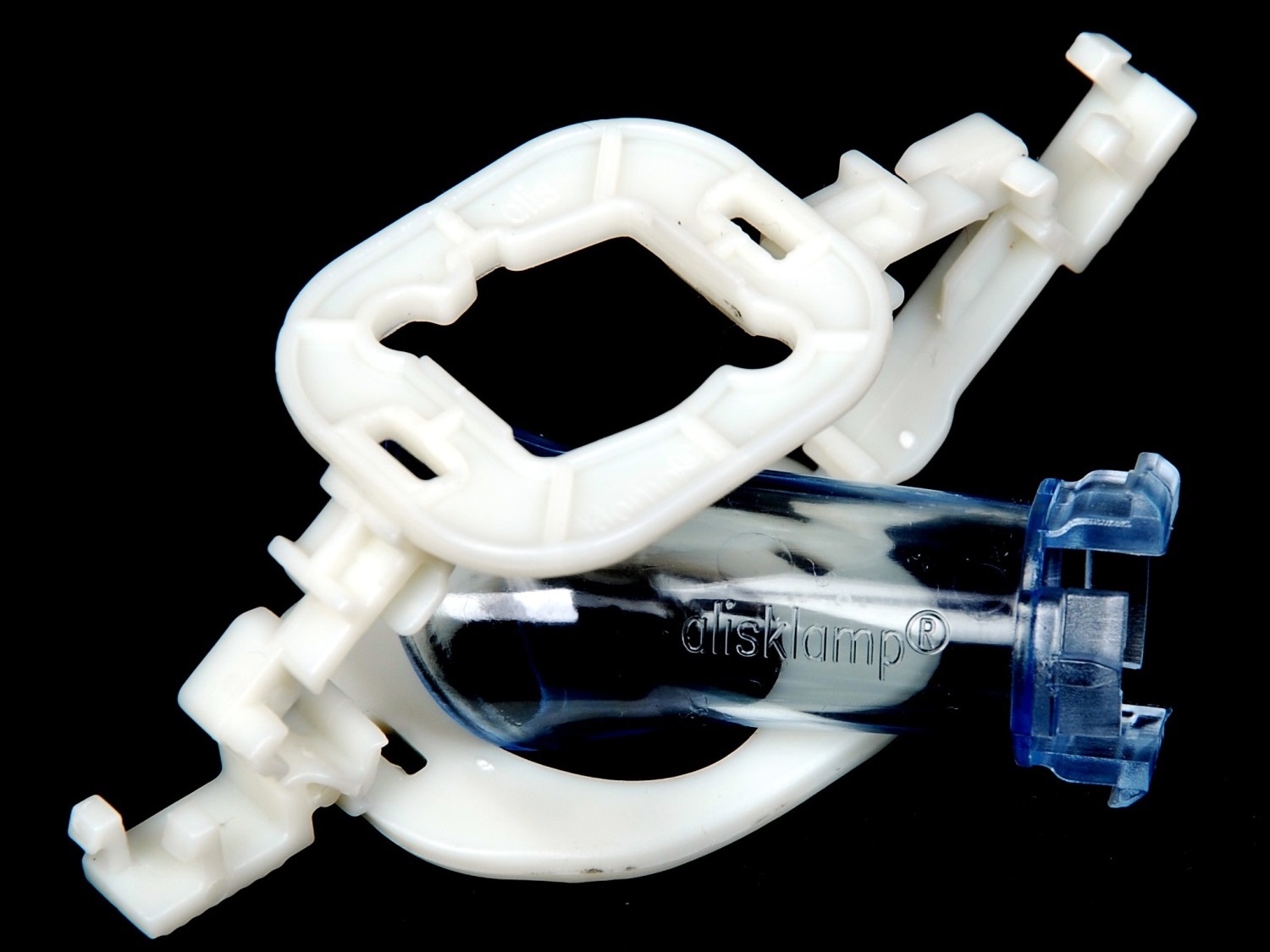| Content Advisory: | This page includes images of child patients. The device is normally used on infant and child patients. |
| Content Advisory: | This page includes images of child patients. The device is normally used on infant and child patients. |
 |
 |
 |
The original (2007) Ali’sKlamp |
The 2013 NeoAlisklamp |
The two versions side-by-side |
| • | Lighter in weight by ⅓. | ||
| • | Sizes over 20mm diameter smaller by ⅓. | ||
| • | Tighter grip at the clamping ring, with consequent reduction in wear time. | ||
| • | Automated detachment, rendering a second visit to the clinic unnecessary. Consequent major savings in clinic time and patient’s travelling costs. | ||
| • | Lower infection risk through use of antibacterial plastics. | ||
| • | V-Scar produced by new shape of clamping ring. | ||
| • | Improved locking mechanism, guarding against both premature removal by a meddlesome patient and unscrupulous re-use of a discarded clamp. | ||
| • | Fitting procedure optionally allows pre-assembly into a single unit before application to the penis, with consequent time saving. | ||
| • | Automated setting of the quantity of retained inner foreskin shortens the procedure and eliminates the risk of an uneven scar line. | ||
| • | Improved alignment of urinary meatus. | ||
| • | Less residual necrotic tissue (now typically 1.5mm) |
The Alisklamp has been the subject of a number of large-scale, published trials. Here is the abstract of the most recent, which frankly reads like a promo fot the device. It comes from Saudi Arabia, where circumcision (unlike Turkey) is commonly performed in the first year of life.
Safety, acceptability, and feasibility of male circumcision using the alisklamp device
Madani Essa, Department of Surgery, College of Medicine, Jazan University, Jazan, Saudi Arabia.
J Pediatr Urol 2022 Sep 27;S1477-5131(22)00378-3. doi: 10.1016/j.jpurol.2022.09.013.Greater than 20 surgical circumcision devices are available worldwide for male circumcision. These have been developed so as to decrease complications. The hemostasis system classifies these devices as crush, clamp or ligature. This study assessed the safety, acceptability, and feasibility of male neonatal circumcision using the Alisklamp device (AKD). The AKD is one of the latest medical devices designed for assisted circumcision. It takes less time to install, has a better complication rate, and has a better cosmetic appearance than conventional surgical circumcision. The study was divided into two sections: assessing the safety of the AKD and evaluating parents' satisfaction. Convenience sampling was used in this study. In the first section, a form was filled by operating pediatric surgeon for children whose parents agreed to participate in the study. In the second section, a total of 100 male children were included in the study based on the sample size guidelines of the World Health Organization. The circumcision was performed by an experienced pediatric surgeon following the manufacturer's instructions. The procedures were completed without AKD failure or unwelcome preputial loss. The results showed that 63.54% of the children were circumcised in their first four weeks of life. About 60.42% of the procedures were completed within 5-10 min. Also, 95.83% of the children had no postoperative complications. Further, 90.63% of parents were satisfied with the AKD and willing to recommend it to others. During the follow-up, all of the children's parents were pleased with the cosmetic and final results of the AKD. In conclusion, the AKD has an outstanding protection profile suitable for male circumcision procedures.
Older reports
Here is the Abstract of the report that appeared in Pediatr Surg Int. 2010 Jun 8. [Epub ahead of print]:Minimally invasive circumcision with a novel plastic clamp technique: a review of 7,500 cases. Senel FM, Demirelli M, Oztek S.
Dr. Sami Ulus Children’s Hospital, Ankara, Turkey.
PURPOSE: We aimed to analyze the outcome of circumcisions performed with a new minimally invasive circumcision device. METHODS: This is the first study, which reports the results of 7,500 children circumcised with minimally invasive technique utilizing a plastic clamp device (Ali’s Clamp ®) in our country. The results of this technique are compared to those of 5,700 children who underwent conventional circumcision.
RESULTS: The most common complication encountered after minimally invasive circumcision technique was found to be buried penis (1.04%). The second complication observed was infection (0.6%), which was significantly lower than the conventional group (p < 0.001). The third complication in plastic clamp group was bleeding with a rate of 0.4%. Bleeding was found to be the most common complication seen after conventional circumcision (5%) and was significantly higher than that of the plastic clamp group (p < 0.001). Total number of complications seen after plastic clamp technique was 2% when compared with 10.4% complication rate occurred after conventional circumcision (p < 0.001). The mean duration of circumcision time with plastic clamp technique was 4.5 ± 1.5 minutes whereas with conventional circumcision it was 23 ± 4 minutes (p < 0.0001).
CONCLUSION: Minimally invasive circumcision technique utilizing plastic clamp significantly reduced the complication rates. The cosmetic appearance after circumcisions performed with this technique was observed to be better than the conventional circumcisions. Due to reduced complications, as well as short duration and ease of application, the minimally invasive technique is suggested as the circumcision procedure of choice.
PMID: 20532526 [PubMed].
CIRCLIST Editor’s note:
This article appears to mis-use the term Buried Penis. In the full article, the authors define it as "healing of wound edges above the glans penis... causing a constrictive ring at this level resulting in phimosis", a matter unrelated to any issue involving a short suspensory ligament within the abdomen. A better term for the problem they seek to describe might be "Induced phimosis resulting from scar line constraint" - after initial definition shortened to just "scar line constraint".